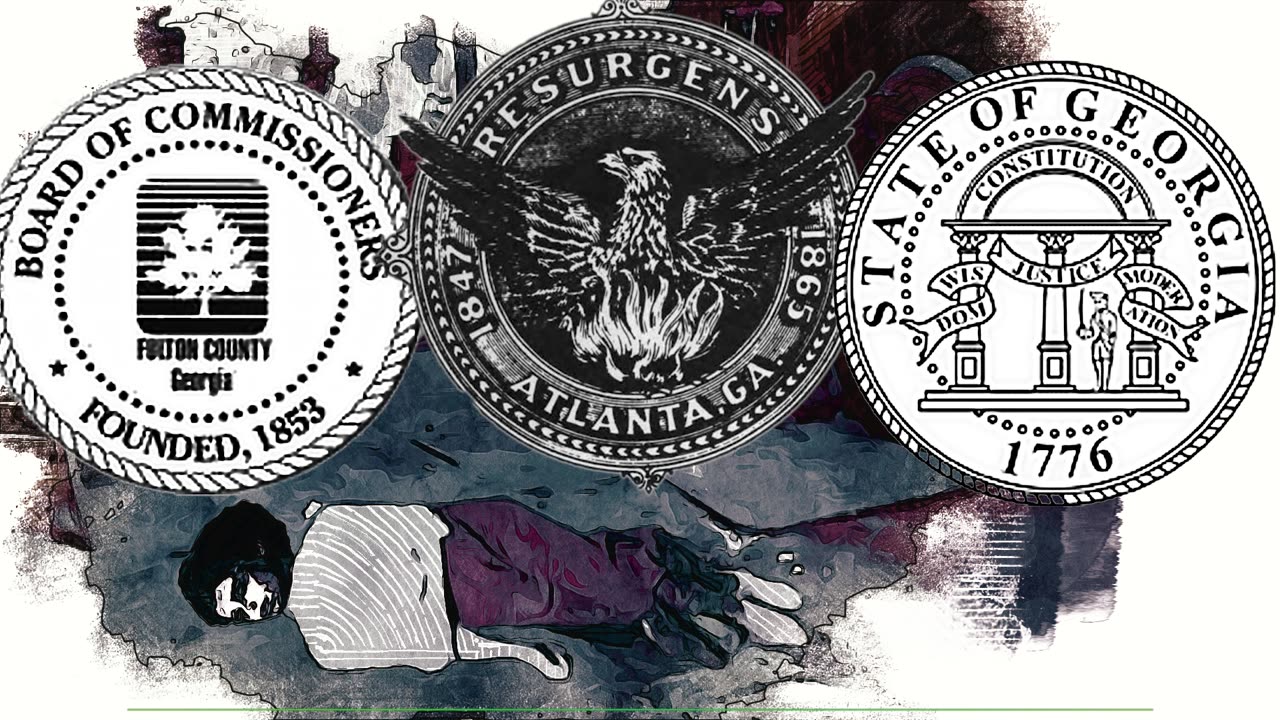Premium Only Content

11 Chapter 7 The Mary Phagan Inquest Starts In Atlanta Georgia Part XI
The Coroner's Inquest Begins After a protracted interview between Frank and Newt Lee that took place Tuesday night at the police station, the coroner's inquest got underway on Wednesday morning. According to detectives, the purpose of bringing the two suspects face-to-face was for Frank to try to get the black suspect to confess. Oh.
In order to testify at the inquest, a large number of witnesses—including factory girls and many others—arrived at the police station early on Wednesday. At 9:10 am, the inquest kicked off. m. In the board of commissioners meeting room, behind closed doors.
Deputy W. F. First witnesses to testify were Anderson and Officer Brown.
They described in great detail how they learned about the murder and how they located the body that gruesome Saturday night. Officer Anderson described in his testimony how the body was torn apart and mutilated in the dim light of the cellar in a vivid and revolting manner. Unless the observers were within at least 15 feet of the body's location, it was impossible to tell that it belonged to a white girl.
The witness claimed that he was present when someone picked up a note close to the body, and that he was able to identify it as the note written on the slip of yellow paper. Later, someone discovered a different note that he couldn't place. A pencil was discovered approximately 5 feet from the girl's body.
A pad that the slip had apparently been torn from was nearby. He described the basement as being a long, narrow enclosure between rock walls with the elevator shaft near the front, a boiler on the right about halfway back, and a partition on the left closing in an enclosure that appeared to be a waste space. Beyond the boiler on the right, there was an open bathroom, followed by the girl's body on the left, and a door at the back.
A close-by elevator housed the girl's left slipper. According to what he could see, she was not wearing a hat. She was wearing something dark, though he couldn't place exactly what it was.
Along with Anderson, Officer Brown testified under oath that it was impossible to distinguish the body from that of a white girl unless one was very close to it. This testimony was extremely damaging to Newt Lee. The girl was white, he claimed, but he couldn't tell until he pulled down the stocking below the knee and saw the flesh. He described the body's horrifyingly filthy appearance and claimed that it could only have gotten so dirty and grimy by being dragged.
He also described how they had attempted to call Frank in the early morning hours but had not been successful until several hours later. A dramatic incident happened during Brown's testimony. The jury was shown the little girl's clothes, which were arranged in a heap on a chair and included a one-piece purple dress with white trimmings and one shoe, a black gunmetal slipper.
Mary Phagan's brother stood up from a chair in the corner, gasped in horror at the pitiful little pile, and bolted from the room with his hands over his head. At 11:45, a. m. Newt Lee stood up for himself.
According to his testimony, he arrived at the factory at 4:00 and left when Frank instructed him to do so at 6:00. He related how anxious Frank was about Gantt visiting the factory, how early one evening Frank had called him on the phone to check on him, and how he had discovered the body. The body was face down, according to detectives and police, but Newt claimed in his testimony that he discovered it face up.
Despite this, Newt swore he didn't touch the body. In response to the officers' claims that he was unable to identify the white girl. He claimed he could tell by the hair, which was always different between black and white women.
J. was the final witness to speak before the jury was dismissed on Wednesday morning. Q. Spear of Cartersville, who swore he saw a man and a girl Saturday afternoon in front of the pencil factory, that they appeared nervous and excited, and that the girl was the same one he saw Sunday at P.J. Mary Phagan died Wednesday afternoon, according to Bloomfield's Chapel. The young newsboy who arrived in town with Mary Phagan in a car, George Epps, was the first witness to give a testimony.
The claim that Mary had told him that Mr. Frank had winked at her and appeared suspicious was an intriguing part of his testimony. E. L. Sentell gave testimony about seeing Mullinax late on a Saturday night with a woman he thought was Mary Phagan. Another witness, a neighbor, claimed to have seen her around 5:00 a.m. near her house, and a third witness, who had previously told detectives he had seen Mary Phagan that day, appeared at the inquest to admit his error. Officers were able to persuade Sentell that he was unsure whether the girl he saw was Mary Phagan.
A factory worker named R. P. Barrett testified that he discovered blood stains close to Mary's machine on the second floor, suggesting that she might have started her struggle for survival there rather than in the basement's pitch-black depths.
When Gantt took the witness stand, he repeated the narrative he had previously given to the detectives. Mary Phagan's stepfather J. W. Coleman described how worried he and her mother were on the night of the murder in his testimony. One of the key witnesses at the hearing was Frank M. Barry, assistant cashier at the Fourth National Bank. He stated that, in his opinion, the notes found near the girl's body were written in the same hand as a number of other notes that the Negro watchman Newt Lee had written at police headquarters for the detectives.
The inquest was then postponed until Thursday. The investigators had made one progress when the inquest ended at 06:00 on Wednesday afternoon. This was the point at which it was determined that the young child had never left the factory following her arrival there on Saturday afternoon to pick up her pay.
Allegations that Mary had been seen at midnight with Mullinax and that girls matching her description had been seen at different times on Saturday afternoon in the area of the factory were each thoroughly investigated and found to be untrue. E l. CENTEL acknowledged that the woman he had seen with Mullinax was Pearl Robinson and not Mary Phagan.
On Saturday afternoon, additional supposed witnesses who saw the young girl came forward to admit that they could have been mistaken. This undergrowth was removed. Officers were finally able to establish a solid basis for the theory that Mary Phagan never made it out of the pencil factory alive.
Gantt and Mullinax were released from custody following their findings at the temporary adjournment of the inquest, which was only in session for a brief period of time on Thursday afternoon. 160 witnesses, the majority of whom were factory workers, had been called by Coroner Donahue, who swore them in at 4:30 p. m. announced that the investigation into the young girl's death would be delayed until the Monday after.
The moment this news was released, a bigger sensation immediately followed. Up until the conclusion of the inquest at police headquarters, Newt Lee and Leo Frank were ordered to be relocated to the Fulton County Tower. The two suspects were reportedly taken to the Tower because there was substantial doubt about whether or not holding them on city warrants was legal given that both had been detained in connection with a state case rather than a city case.
Except for the names franks, Read, Georgia, Fulton County, and the jailer of said county, the coroner's warrants used to transport the two men to the Tower were identical in every instance. Greetings. Leo M. Frank, who is suspected of killing Mary Phagan, must be taken into custody by you. You must also keep Leo M. Frank in your care while the coroner of that county conducts additional research into Mary Phagan's death. Under my hand and official signature, herein fail not given.
May 1, 1913, has just begun. Coroner Paul Donahue signed. There seemed to be little doubt that in the persons of Frank and Newt Lee, the detectives had the key to the mystery after the two men in the Tower on Thursday and the release of two other ex-suspects.
But there was still another man fighting the legal system, a man whose arrest at the time generated so little buzz that the newspapers devoted just one paragraph to it. The most shocking statement ever made up until the trial began was made by this man later, shocking the public. James Jim Conley was the man.
At the pencil factory, a black sweeper. Conley was taken into custody at police headquarters along with the factory's Snowball elevator boy at 2:00 on Thursday afternoon on suspicion of a crime. The latter was never a key player in the case.
The newspaper account of Conley's arrest at the time demonstrates the minimal interest it generated at the time. Detectives made the sixth arrest at 1:00 on Thursday in the Phagan murder case. James Conley, a black sweeper working at the National Pencil factory, was observed cleaning a shirt at a sink in the back of the structure.
Detectives arrived and took the man into custody before he could finish his work after being called. On the man's shirt, there were some marks. He says they are rust stains.
He will be detained by the police at least until a chemical test can conclusively determine whether or not blood was used to cause the stains. The black man informed the police that the shirt was the only one he owned and that he had washed it so he could wear it to the inquest he had been called to. Police currently accept his account, and tips and theories continue to pour into the detective's office.
Many of Frank's friends were personally working on the case in an effort to dispel the suspicion that hung over the well-known young superintendent. He had a large circle of friends and was well-known in the community. He was the president of the local Hebrew group B'nai B'rit, a leader in the church and social work, a successful businessman with a college degree, amiable to talk to, and endowed with a certain amount of charisma and magnetism.
Frank's friends enthusiastically rallied to his defense even at that early hour when only the most trivial of circumstances were used against him. The detectives' office was inundated with theories about how Mary Phagan died and how her murderer might be apprehended. People gave the officers instructions on how to proceed over the phone.
Many of them visited the office in person, and the office also received hundreds of letters with advice and theories from this and twelve other states. Although most people signed their names, many of the letter writers used pseudonyms. Numerous criminologists had written letters offering to share their theories in exchange for payment.
Several letters were sent by mystics and seers who had communicated with the dead and discovered the murderer's identity in this way. Two women who had nightmares about the murder were among the intriguing callers at police headquarters. Both claimed to have seen Mary Phagan engaged in a bloody struggle with the murderer.
The ladies arrived close together, but their dreams weren't the same. They both accurately described the murderers from their dreams to the chief. While Frank's friends flocked to his defense, there was an equal amount of criticism directed at both him and the negro.
Threats and mutterings started to permeate the atmosphere. The detectives then took Lee and Frank to the tower to demonstrate their conviction that, in the eyes of the general public, either one of them was the criminal. The atmosphere that Thursday night had reached a fever pitch and ugly things were predicted.
Officials from the city, county, and even the state took extreme precautions out of fear for what might occur in the situation at the time. Joseph M. Brown, the governor, gave adjutant general in order to prepare the troops for an emergency, J. Van Holt Nash is to speak with the Fifth Regiment National Guard of Georgia officers. The governor also issued a warning to the police and jail administration to be alert for any indications of unrest among the populace. Colonel E. E. Pomeroy, took notice of the governor's warnings. By being in charge of the Fifth Regiment, gathered his soldiers at the Auditorium Armory, a few blocks from the tower housing Frank and Lee's prison, and kept them there until late at night. At 11:30 p. m.
The soldiers were granted permission to go home. Although rumors and speculations continued to grip the city and the state, the rumors of mob violence had been disproven from Thursday until the coroner's jury reconvened again on Monday morning. The public's insatiable appetite for news persisted, and on Saturday night the militia was once more ordered to stand by in case trouble should arise.
Legal counsel H. A lengthy meeting with Coroner Paul Donahue and Chief of Detectives Lanford was held by M. Dorsey on Saturday morning. It was reported that this meeting led to the calling of additional witnesses for the inquest and the unification of the city and state agencies involved in the investigation.
The city was buzzing with rumors all day Saturday that one of the two prisoners in the tower had made a confession, rumors that the authorities vehemently denied and later proved to be completely untrue. Consequently, the first week after Mary Phagan's body was discovered came to a close with the best investigators from the county, city, state, and outside agencies working on the case, two suspects in the tower, and the entire state anticipating what the coroner's inquest might reveal when it resumed Monday afternoon at 2:00.
-
 1:46:28
1:46:28
Tucker Carlson
3 hours agoErnst Roets: Attacks on Whites in South Africa, Attempts to Hide It, and Trump’s Plan to End It
96.3K61 -
 42:26
42:26
Stephen Gardner
1 hour ago🔥You WON'T BELIEVE What Adam Schiff Said About Trump and Americans!!
13.3K21 -
 1:13:34
1:13:34
Russell Brand
16 hours agoThey Lied to Us – The Vaccine, Big Pharma & Global Corruption with Dr. Aseem Malhotra – SF546
180K106 -
 42:08
42:08
CryptoWendyO
2 hours ago $0.73 earnedTRUMP PUMPS CRYPTO MASSIVE ANNOUNCEMENT COMING
13.9K2 -
 1:57:58
1:57:58
The Charlie Kirk Show
3 hours agoZelensky’s Setup? + Border Recovery | Sen. Mullin, Hemingway, Bensman | 3.3.25
112K40 -
 55:30
55:30
The Dan Bongino Show
6 hours agoThe Explosive White House Meeting That Changed Everything (Ep. 2434) - 03/03/2025
826K1.67K -
 2:10:15
2:10:15
Benny Johnson
4 hours ago🚨 AOC Going to JAIL For Leaking ICE Raid!? Trump to END Military Aid to Ukraine After WH Boss Move
151K186 -
 1:01:27
1:01:27
Grant Stinchfield
3 hours ago $3.44 earnedThe Real Story Behind the War in Ukraine
31K5 -
 1:05:36
1:05:36
The Rubin Report
5 hours agoTrump & Zelenskyy’s First Reactions to Disastrous Meeting
96K40 -
 2:02:45
2:02:45
Steven Crowder
6 hours agoShould Trump Ditch Free-riding NATO After Zelensky Blowup?
538K342